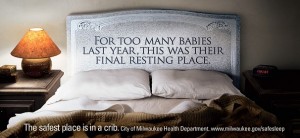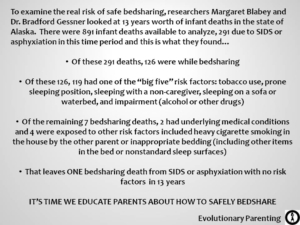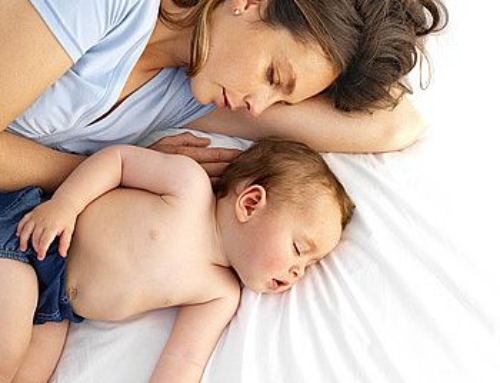A new fear-mongering campaign is underway in Ohio regarding safe infant sleep. If you remember a few years ago, Cincinnati hosted their very own fear-mongering campaign against bedsharing specifically, using images such as these to make their point:
The new campaign goes even broader, focusing on not only bedsharing, but also unsafe crib practices (such as having toys and other items in the crib with the baby). This is at least an improvement over the sole focus on bedsharing that seems to be the go-to “evil” in the USA, but it still fails. Epically. There are two main problems with these campaigns, problems I have actually been writing on for four years, but which seem to be continuously ignored in favour of these campaigns that, if history tells us anything, don’t work.
The first issue pertains to bedsharing specifically and is the complete lack of focus on education and individual circumstances. Over and over in the USA, bedsharing is condemned as being dangerous per se, yet we have a wealth of research that actually contradicts this. Bedsharing can be dangerous, but it can also be done safely. When the focus of any campaign is simply “don’t do it”, ignoring culture, instinct, and individual family needs, too much is lost and the message is ignored.
Bedsharing facilitates better sleep for many families, something that is consistently an issue, especially in societies where women are back at work far too soon (as an aside, if you want to fight this in the USA, please check out this downloadable letter to send to your representative). Bedsharing facilitates breastfeeding, something that is considered a public health issue in the USA, yet too little is done to actually help women reach this goal of breastfeeding – both their own and that for public policy. Bedsharing facilitates closeness or synchrony, allowing mom (a focus on mom because it is biologically the safest person to be sleeping next to mom, though dads can and do bedshare safely) to develop a strong connection to her baby (and although this isn’t the only way, it is certainly an easy way, especially when mom is gone all day at work). Bedsharing facilitates child independence, with infants and children who bedshare often showing greater independence later in life than their solitary sleeping counterparts.
This is why, despite years of the anti-bedsharing campaigns ongoing, bedsharing continues to rise. Yet without appropriate education on safe bedsharing, families continue to take risks, not realizing if they have individual factors that make their situation more risky for their infant. And if they do, they aren’t given the information on how to change these situational factors if at all possible.
The second issue pertains to so much more than even sleep, but is paramount in this discussion: Poverty. This isn’t saying that people in poverty are “worse” parents or anything like that. Hardly. The problem is that in poverty-stricken areas, there are a host of other environmental factors that influence the safety of infant sleep, both bedsharing and in a crib. Take, for example, smoking. Smoking rates have been known to be higher in areas of greater poverty (likely as a means of stress relief) and also contribute to SIDS rates.
Poverty means more shift work, with overtired parents who will do what they can to get the sleep they need to function. Poverty means less access to safe sleep spaces, with parents using what they can to get their child to sleep which may mean blankets, toys, or dangerous bedsharing. Poverty means less access to education and support to assist in parenting decisions and parenting more generally. Poverty means greater use of formula and a higher risk of “stretching” formula which are implicated in SIDS. In short, poverty matters, but it is far easier to try and focus on the symptom than the cause.
So as long as our government and policy experts continue to focus on symptoms instead of the problems and being dictatorial instead of educating, we will continue to see infants die. It’s not a good thought, it’s not a happy one, but it’s the reality. If we want to curb this, we need to focus on changing a broken system and empowering parents with education and resources that support them and their circumstances. It may not be easy, but it should be worth it.
You can read up on the REAL risks associated with bedsharing and how to bedshare SAFELY using the links below:
Bedsharing: Risks and Realities
Bedsharing and SIDS: The Whole Truth
The Do’s and Don’ts of Bedsharing
Does Bedsharing Increase the Risk of Death for Younger Infants?
Bedsharing and Formula Feeding
Bed-Sharing and Co-Sleeping: Research Overview (by Dr. Helen Ball)








I believe these kind of campaigns are really damaging because they prevent any real discussion on safe cosleeping. For example, when my baby boy was born he would only sleep tummy-to-tummy on top of me. Although I was prepared to cosleep I hadn’t expected this particular position and was terrified that he would slip off, A quick search online resulted in some quite alarming suggestions such as propping up the baby or mother with pillows overnight (which I assume would create quite a big suffocation risk). I felt quite at loss, since I knew the mainstream would just tell me to “put him in the crib” whereas the cosleeping advocates went on about how “mother-baby diads naturally choose a safe position with baby on the back or side”.
[…] With yet another “safe sleep” campaign that focuses on fear-mongering over education and real statistics, it’s time we looked at what is going on … Bron: Safe Sleep: Is Fear Mongering Taking Over Common Sense? | Evolutionary Parenting | Where History And… […]
[…] Dan toch ook nog maar wat borstvoeding, opvoeding en actievoeding: Het is 3:42 en ik ben net wakker. Naast mij ligt mijn kleine dame zachtjes te snurken. Ik voel dat ik eigenlijk naar de wc moet, maar ik lig nog zo lekker. Mijn bed is heerlijk zacht en warm, terwi… Bron: Synchroniseren Dragen en Voeden Forum Als verse basisschool moeder loop ik nog tegen wat logistieke problemen aan. Bron: Logistiek voor de beginnende basisschool ouder – LeesVoer With yet another “safe sleep” campaign that focuses on fear-mongering over education and real statistics, it’s time we looked at what is going on … Bron: Safe Sleep: Is Fear Mongering Taking Over Common Sense? | Evolutionary Parenting | Where History And… […]